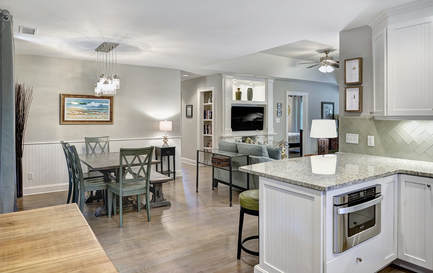The Facts about Open floor Plans and Traditional Floor plansDeciding upon a floor plan for your new or newly renovated home means more than just the aesthetics. The floor plan you select will influence construction costs, traffic flow, natural light, and activity level. Keeping in mind the size of the space, the amount of people using the rooms, their preferences, and the primary uses of the rooms, will determine if homeowners want an open floor plan, a traditional floor plan, or a combination of both.
First, let's define what an open floor plan means. Generally, an open floor plan involves one or more large open rooms which has more than one function. This means that a family room can incorporate a kitchen and dining room in one large, open space. According to budgetdumpster.com, Open floor plans have the following advantages: 1. CREATE AN ILLUSION Open floor plans can make a small area feel much larger. In smaller homes, this type of floor plan can make an older home feel new. 2. DESIGN FLEXIBILITY A big, open area will allow you to buy that larger size furniture that would crowd a smaller room. This will allow homeowners greater design flexibility. 3. PROMOTES INCLUSIVENESS An open floor plan allows family members to interact with each other while being in other parts of the room, engaged in different activities. 4. BABYSITTING Parents will be able to keep an eye on their children while preparing dinner or setting the table. Children will have more room for their activities, but still be kept safe and out of trouble. 5. ENTERTAINING An open floor plan allow for a greater number of guests in one space while allowing groups to gather in different areas for different activities. 6. NATURAL SUNLIGHT An open floor plan means fewer walls which allows for more sunlight while saving energy. As you can see, open floor plans have many advantages and are currently very popular with designers. In terms of resale value, open floor plans rate very high in today's housing market. Traditional floor plans have their advantages, also. Many of the homes built before the 1990's have a traditional floor plan. This allows for rooms to be more functional and private. These are the advantages to a traditional floor plan: 1. EXPENSE Knocking down walls can be expensive, especially if the wall being removed is a load bearing structural wall. This means that this wall may carry the weight of the house roof or the floor above. When working with a structural wall it may entail hiring a contractor and/or an engineer and get approval from the local city. 2. PRIVACY Walls and doors allow you to keep that area private. Homeowners are able to contain messes or private items from surprise guests. Smaller rooms are easier to clean and maintain. 3. WALLS Open floor plans have few walls. Traditional floor plans allow you to decorate and hang artwork and important photographs to display. For some artwork, open sunlight can be harmful. 4. SPECIALTY AND FUNCTION Traditional floor plans allow you to have specific rooms for specific functions such as offices or craft rooms. Homeowners can create a room just for their own purpose and allow or not allow guest access. 5. NOISE Having walls will keep the noise of a dishwasher or television from traveling to the other parts of the house. This type of floor plan will allow one area of the home to entertain guests while allowing privacy in another part of the home. Traditional floor plans also offer a great many advantages. In some newer homes with traditional floor plans, heat and air conditioning to be turned down or off, resulting in energy savings. The good news is that homeowners don't have to pick one or the other. Very often open floor plans are the choice for the main level of the home while a traditional floor plan is used for the upper level or bedroom area of the home. Keep in mind that as children grow up, room configuration may need to change. The important thing to remember is that if the current floor plan in your home is not meeting your needs, it can be changed to reflect how your home functions today. Here are some ideas how to change an open or closed floor plan into more usable, functional space: 1. Extra or unused attic, basement or garage space can be turned into additional bedrooms, an office, or family room. 2. Two adjacent bedrooms can be combined to make one large bedroom. 3. Add bathroom by borrowing space from a larger room. (It helps if it is close to plumbing) 4. Increase the size of a bathroom by expanding into a linen closet or storage space. 5. Converting decks or balconies into interior rooms can add space to small rooms. 6. A patio already has the foundation for a new room. 7. Flat roofs can be converted into a deck or covered porch. 8. A sunroom can be converted into a new room or add space to a room. Whatever floor plan you choose, before you start, make a list of the priorities you desire in your home. Your list should include the rooms where your family seems to congregate the most and any specialty rooms needed. In smaller homes look in crooks and crannies for creative ways to add drawers, shelves, closets, or cabinets for more storage space. Harper Construction> has built a reputation for fine quality custom construction, attention to detail and, strong customer service. Check out their entire portfolio of work on Houzz.com>. If you found this information helpful click "Like" or "Share" below and post this to your social media pages. Your "Likes" and "Shares" help others like you find the information they need. We are happy for you to re-publish this article on your website or in your company newsletter with credit to Harper Construction as the author and a link to our website http://www.chrisharperconstruction.com. The URL for this article is http://www.chrisharperconstruction.com/blog/open-floor-plan-vs-traditional-floor-plan Email us with any questions.
1 Comment
Ida Lux
2/25/2021 04:08:23 am
Good
Reply
Leave a Reply. |


